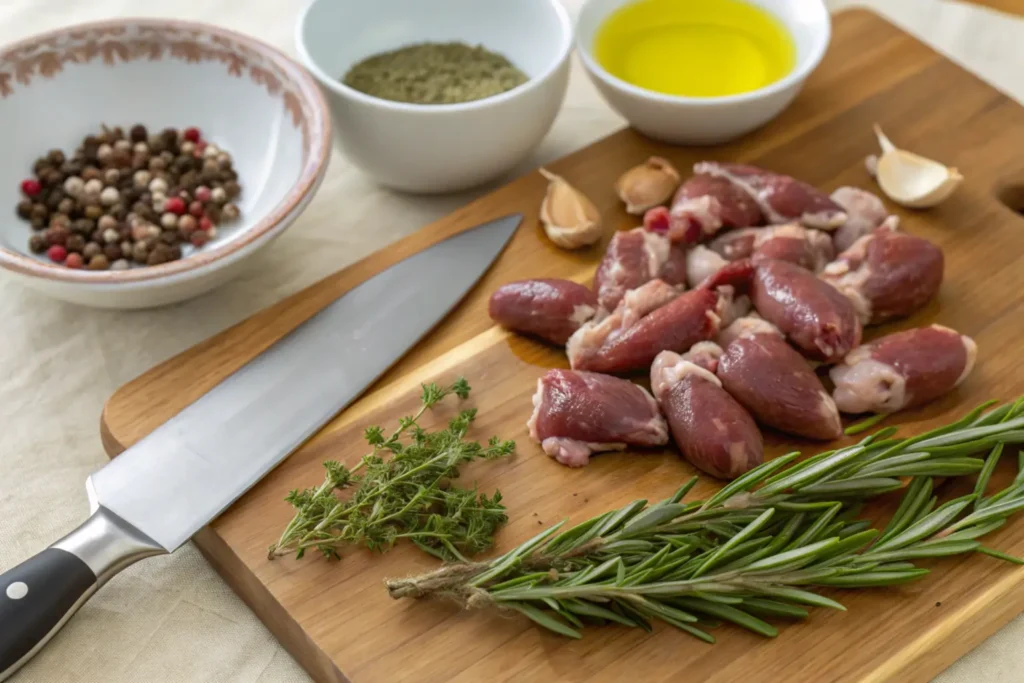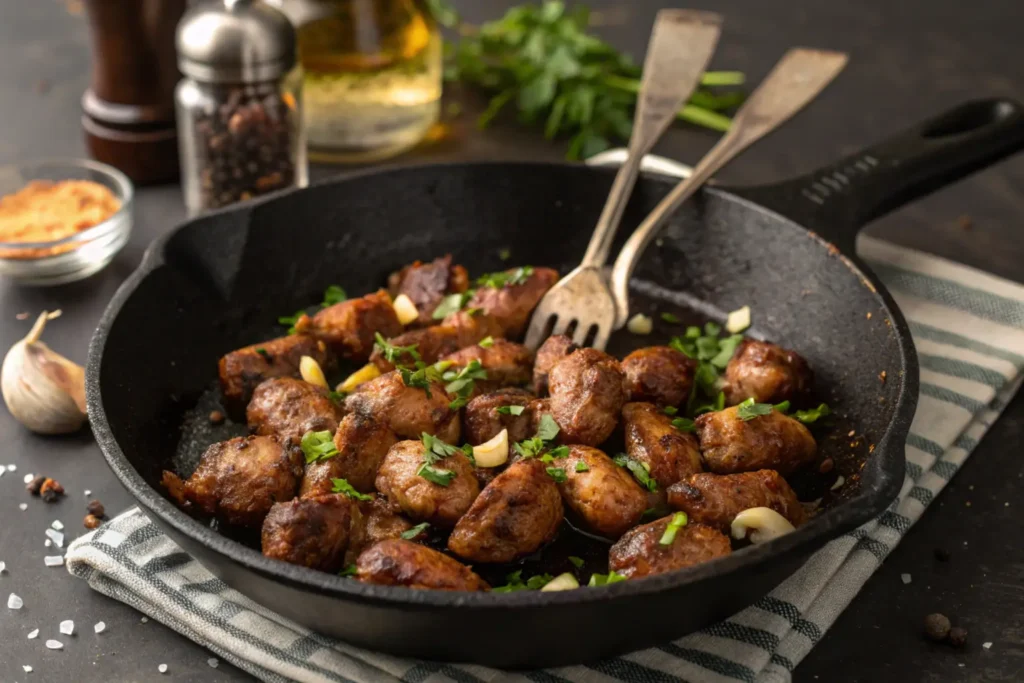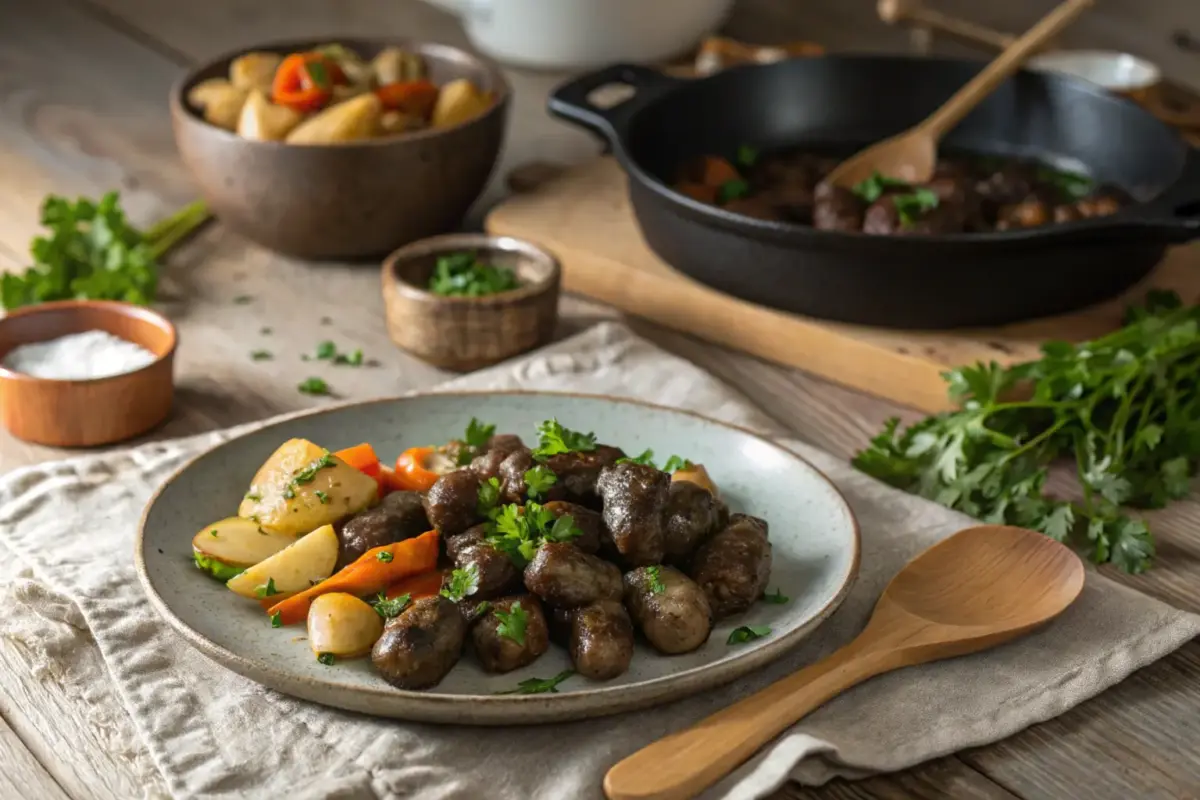Introduction to Cooking Chicken Hearts
Cooking chicken hearts might sound a little adventurous, but trust me, they’re a hidden gem in the kitchen. These bite-sized delights are not only budget-friendly but also packed with flavor and nutrients. Whether you’re pan-frying, grilling, or roasting, mastering the art of cooking them is key to bringing out their best. And the big question is always, how do you know when chicken hearts are done? With the right preparation and techniques, you’ll easily recognize when they’re perfectly cooked—tender, juicy, and safe to eat. Let’s get started! For more about the health aspects of chicken hearts, check out Are Chicken Hearts Healthy to Eat? A Complete Guide to Nutrition and Benefits.
Why Cooking Chicken Hearts Properly is Crucial
Cooking chicken hearts the right way is more important than you might think. These small but mighty pieces of meat cook quickly, so timing and technique matter. If you overcook them, they turn rubbery and lose their tenderness. On the flip side, undercooked chicken hearts are unsafe to eat and can ruin your dish. And let’s not forget flavor—perfectly cooked chicken hearts are juicy, rich, and packed with a satisfying bite. To learn about a simple and flavorful technique, see Sautéed Chicken Hearts.
Nutritional Value of Chicken Hearts
Okay, here’s the part that might surprise you. Chicken hearts aren’t just tasty; they’re a nutritional goldmine. They’re high in protein, rich in iron, and loaded with vitamins like B12, which is great for energy and brain health. Plus, they’re a good source of zinc and selenium, two minerals your body needs to stay in tip-top shape. If you’re trying to eat healthy without blowing your budget, chicken hearts are a solid choice. And hey, eating organ meats is also a more sustainable way to enjoy poultry.
Preparing Chicken Hearts for Cooking
Cleaning and Trimming Techniques

Before you even think about cooking, you’ve got to prep those hearts. It’s not hard, but it does take a little time. Start by rinsing them under cold water to remove any leftover blood or debris. Once they’re clean, check for any fatty bits or connective tissue and trim them off with a sharp knife. Some chicken hearts might still have the little tube-like valve attached. It’s not harmful, but most folks prefer to snip it off for a cleaner look and texture. Trust me, a little prep work here makes a big difference later.
The Role of Marinades in Tenderizing Chicken Hearts
Now, this is where the magic happens. Marinades aren’t just for flavor—they also help tenderize the meat. Since chicken hearts are a muscle, marinating them can break down some of the tougher fibers, making them softer and more enjoyable to eat. A simple mix of olive oil, garlic, lemon juice, and your favorite spices works wonders. Let them soak for at least 30 minutes, or even overnight if you’ve got the time. Bonus tip: adding a splash of vinegar or soy sauce to your marinade gives them a little extra tang and tenderness. It’s a game changer, I swear.
Cooking Techniques for Chicken Hearts
Pan-Frying Chicken Hearts for a Quick Meal

If you’re short on time but still want a flavorful meal, pan-frying is the way to go. Start by heating a generous splash of oil in a skillet over medium-high heat. Once the oil is shimmering, toss in the chicken hearts, making sure they’re spread out in a single layer. Season them with salt, pepper, and maybe a sprinkle of paprika for a smoky kick. For more inspiration on flavorful poultry preparations, explore What is Chipotle’s Chicken Made Of? Everything You Should Know.
Grilling Tips for Juicy and Smoky Chicken Hearts
Grilling chicken hearts might just become your new favorite thing. The grill adds a smoky flavor that takes them to the next level. Start by threading the hearts onto skewers. This makes it easier to flip them and prevents smaller pieces from falling through the grates. Preheat your grill to medium-high heat, and make sure to oil the grates to avoid sticking. Grill the hearts for about two to three minutes per side, basting them with a little garlic butter or marinade as they cook. Keep an eye on them—overcooking can make them tough. Pair them with a fresh salad or roasted veggies for a complete meal.
How to Roast Chicken Hearts in the Oven
When you’re in the mood for a hands-off cooking method, roasting is your best bet. Preheat your oven to 400°F and line a baking sheet with parchment paper. Toss the chicken hearts in olive oil, salt, pepper, and any spices you like—cumin or smoked paprika work really well. Spread them out evenly on the baking sheet to ensure they cook evenly. Roast them for about 15 to 20 minutes, giving them a quick stir halfway through. You’ll know they’re ready when they’re slightly crispy on the outside but still juicy inside. These are great for meal prep or as a protein-packed snack.
Braising Chicken Hearts for Tenderness
Braising is the go-to method if you’re looking for melt-in-your-mouth chicken hearts. Start by searing them in a hot pan with a little oil to lock in the juices. Once they’re browned, remove them and set them aside. In the same pan, sauté onions, garlic, and maybe some mushrooms for added flavor. Add a splash of broth, wine, or even coconut milk, then return the hearts to the pan. Cover and let them simmer on low heat for about 20 to 30 minutes. The slow cooking process tenderizes the hearts and infuses them with all those rich flavors. Serve this over mashed potatoes or crusty bread to soak up the sauce.
Alternative Methods: Using an Air Fryer or Slow Cooker
If you’ve got an air fryer or slow cooker, you’re in luck because both are fantastic tools for cooking chicken hearts. For the air fryer, preheat it to 375°F and toss the hearts in a light coating of oil and your favorite spices. Cook them for about 10 to 12 minutes, shaking the basket halfway through for even cooking. They come out crispy on the outside and tender inside. For the slow cooker, throw the hearts in with some onions, garlic, and broth. Let them cook on low for about four to six hours. The result is soft, flavorful hearts that practically fall apart. Both methods are simple and hands-free, making them perfect for busy days.
Recognizing When Chicken Hearts Are Fully Cooked
Visual Cues: How Appearance Changes During Cooking
To know when chicken hearts are ready, watch for changes in color. Raw chicken hearts start as a deep red, but they turn brownish-gray as they cook. If you’re frying or grilling them, a golden-brown sear or crust develops on the surface, signaling they’re done. For roasting or braising, check for clear juices running from the hearts instead of pink. These visual cues help you determine doneness without needing extra tools.
Checking the Internal Temperature for Safety
Use a meat thermometer to confirm the internal temperature reaches 165°F. Insert the thermometer into the thickest part of a chicken heart to get an accurate reading. If you don’t have a thermometer, cut one open to check the center. Properly cooked chicken hearts show no signs of raw or pink meat. Hitting the correct temperature ensures a safe and enjoyable meal.
Texture Test: The Perfect Bite
Pay attention to the texture while testing for doneness. Properly cooked chicken hearts feel tender with a slight firmness, offering a satisfying bite. If they feel too rubbery, they may have stayed on the heat too long. On the other hand, hearts that are overly soft might need a bit more time. Take a small bite to assess the texture—it should feel balanced, neither tough nor mushy.
Common Mistakes to Avoid When Cooking Chicken Hearts
Overcooking: How it Affects Flavor and Texture
Overcooking chicken hearts is a common mistake that can completely ruin their flavor and texture. When they stay on the heat too long, they lose moisture, becoming dry and rubbery instead of tender and juicy. Since chicken hearts are small, they cook quickly, so timing is everything. The key is knowing how do you know when chicken hearts are done. Watch for visual signs like a browned exterior and an internal temperature of 165°F. Sticking to recommended cooking times ensures your chicken hearts stay flavorful and easy to enjoy.
Undercooking: Identifying Raw Chicken Hearts
Undercooking chicken hearts is not just a culinary mistake—it can also pose health risks. Raw or undercooked chicken hearts have a soft, mushy texture and may retain a reddish-pink center. To avoid this, check their color and firmness during cooking. Fully cooked chicken hearts should feel tender but not overly soft, and their color should turn from deep red to brownish-gray. Wondering how do you know when chicken hearts are done? Use a meat thermometer to ensure the internal temperature reaches 165°F. This small step guarantees both safety and great taste.
Enhancing the Flavor of Chicken Hearts
Seasoning Tips for Best Results
Seasoning is everything when it comes to chicken hearts. A simple combination of salt, pepper, and garlic works wonders, but you can get creative with your spices. Paprika adds a smoky depth, cumin gives a warm earthiness, and a splash of soy sauce or Worcestershire sauce can bring a savory umami kick. Don’t forget to season them generously before cooking, and if you’re marinating, let the flavors soak in for at least 30 minutes to maximize taste.
Pairing Chicken Hearts with Complementary Dishes
Chicken hearts pair well with a variety of sides, so you’ve got plenty of options to round out your meal. For a light and fresh contrast, serve them with a crisp green salad or roasted vegetables. If you’re craving something hearty, try them with mashed potatoes, rice, or pasta. Their rich, savory flavor also complements bold sauces like chimichurri, teriyaki, or even a spicy sriracha mayo. Experiment with combinations until you find your favorite pairing.
FAQs About Cooking Chicken Hearts
How do you know when chicken hearts are done cooking?
Chicken hearts are ready when their color changes from dark red to a light brownish-gray. They should feel tender but firm to the touch. If you have a meat thermometer, check for an internal temperature of 165°F to ensure they’re safe to eat. Juices should run clear, and there should be no raw or pink parts inside.
How to tell when chicken strips are done?
To check if chicken strips are done, look for a golden-brown exterior and a firm texture. Cut one open to confirm the inside is fully cooked. The meat should be white with no pink, and the juices should run clear. For the most accuracy, use a meat thermometer and check for an internal temperature of 165°F.
Are chicken hearts supposed to be chewy?
When cooked correctly, chicken hearts should be tender with a slight chew. They’re naturally firmer than other cuts of chicken, but they shouldn’t feel rubbery or tough. If they’re overly chewy, they might have been overcooked. To achieve the right texture, follow recommended cooking times and methods.
How to tell if chicken hearts have gone bad?
To check if chicken hearts have spoiled, look for changes in color, texture, or smell. Fresh chicken hearts should be a dark red color and feel firm to the touch. If they appear gray, slimy, or have an unpleasant odor, it’s best to discard them. Always store chicken hearts in the refrigerator and cook them before the expiration date to ensure freshness.
Conclusion: Perfectly Cooked Chicken Hearts Every Time
Cooking chicken hearts might seem intimidating at first, but with the right techniques and a little practice, you’ll be serving them up like a pro in no time. From pan-frying to grilling and everything in between, these tiny powerhouses can shine in a variety of dishes. Remember to season generously, cook them just enough to keep them tender, and pair them with sides that complement their rich flavor. With these tips, you’ll always know when your chicken hearts are perfectly cooked and ready to enjoy.


2 thoughts on “How Do You Know When Chicken Hearts Are Done? A Complete Cooking Guide”